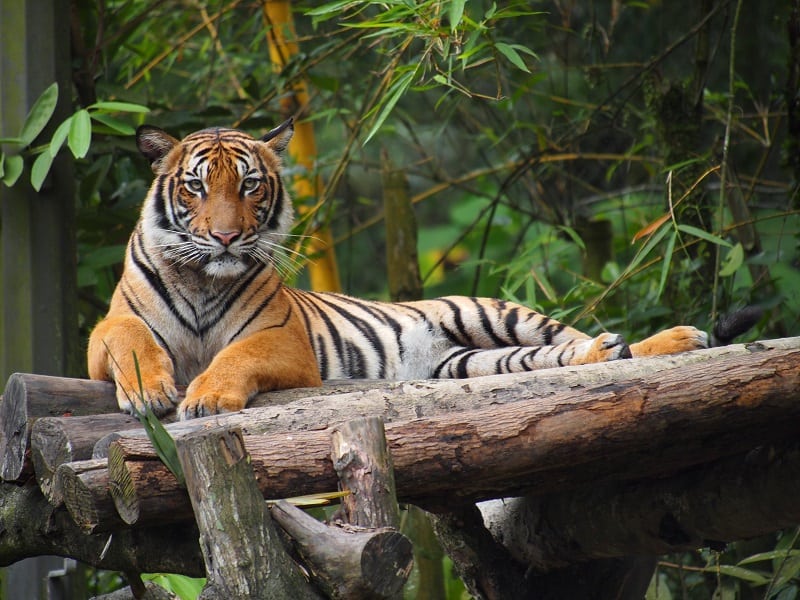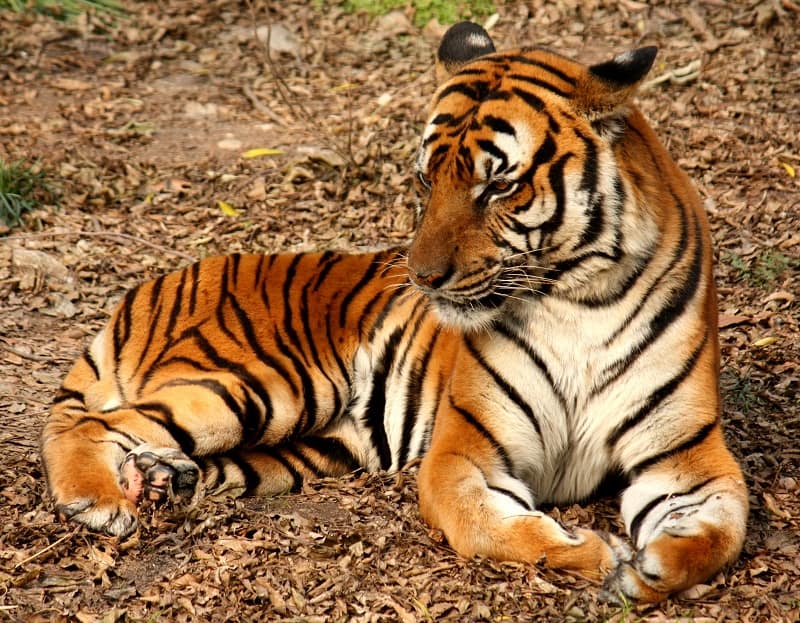Tigers are some of the coolest and most recognizable animals in the world. They’re staples at zoos around the world and have fascinated humans for centuries. However, despite the adoration, tigers are one of the most threatened species in the world. Tiger numbers have continually been in decline for decades and there are less than 4,000 tigers remaining in the wild.
Of every documented tiger subspecies, only six remain and all of them are endangered or critically endangered. One subspecies of tiger on this list is even currently considered extinct in the wild, with few individuals in captivity. While many factors contribute to the decline of the world’s wild tiger population, the largest threat they face is from human activities, including illegal poaching, habitat loss due to human expansion, and human conflict (killing tigers because they pose a “threat”). Hopefully, raising awareness of tigers’ current circumstances can help save these majestic creatures.
As of September 2019, the population estimates for these tiger subspecies is as accurate as possible. This information will be updated as needed.
- Bengal Tiger
- Siberian Tiger
- Sumatran Tiger
- Indochinese Tiger
- Malayan Tiger
- South China Tiger
Location: Indian Subcontinent (Bangladesh, Nepal, and Bhutan)
Current Conservation Status: Endangered
Scientific Name: Panthera tigris tigris

photo source: Wikimedia Commons via SusuMa
While there are more Bengal Tigers than the other five subspecies combined, Bengal Tigers are still endangered animals. Like all tigers, the Bengal Tiger population is in decline, primarily facing human threats, especially illegal poaching.
Did You Know?
The reason for the high number (compared to the other tiger subspecies) of Bengal Tigers is that they have been captive bred since 1880 and are widely crossbred with other tiger subspecies.
Location: Russian Far East; Northeast China; and possibly North Korea
Current Conservation Status: Endangered
Scientific Name: Panthera tigris altaica

photo source: Wikimedia Commons via Dave Pape
Unfortunately, over hunting nearly decimated the wild Siberian Tiger population and its numbers have fluctuated over the years. After Russia became the first country to grant a tiger subspecies (the Siberian Tiger) full protection, its population has stabilized at more than 500, but less than 600.
Did You Know?
In captivity, the Siberian Tiger is the largest of all the remaining tiger subspecies, growing as large as 660 pounds (300 kilograms) and 10.75 feet (3.28 meters) long. However, in the wild, the Bengal Tiger is bigger.
Location: Sumatra, Indonesia (Sundra Islands)
Current Conservation Status: Critically Endangered
Scientific Name: Panthera tigris sumatrae or Panthera tigris sondaica

photo source: Wikimedia Commons via Clément Bardot
DNA analysis suggests that the Sumatran Tiger became isolated from other tiger populations after a rise in sea level that occurred between 12,000 to 6,000 years ago. Due to this, Sumatran Tigers evolved differently and have no problem living on their island home. The Sumatran Tiger population is in decline mainly because of human activity like the expansion of palm oil plantations.
Did You Know?
The Sumatran Tiger is the smallest subspecies of tiger, and also has the darkest fur (very dark orange) and the highest density of stripes compared to the other tigers.
Location: Myanmar; Thailand; Laos; Vietnam; Cambodia; and southwestern China (probably extinct in this area)
Current Conservation Status: Endangered
Scientific Name: Panthera tigris corbetti

photo source: Wikimedia Commons via Lotse
Although all tigers are fairly mysterious, the Indochinese Tiger is solitary and very elusive, so little is known of the animal’s behavior in the wild. Of all the remaining tiger subspecies, Indochinese Tigers are the least represented in the captive population. Since the Malayan Tiger was split off into its own subspecies in 2004, there are less than a handful of Indochinese Tigers in zoos around the world.
Did You Know?
The Indochinese Tiger’s scientific name, Panthera tigris corbetti, pays homage to Jim Corbett, a British hunter who took down man-eating tigers and leopards in India, but later became a conservationist
Location: Southern and central parts of the Malay Peninsula; southern tip of Thailand
Current Conservation Status: Critically Endangered
Scientific Name: Panthera tigris jacksoni

photo source: Wikimedia Commons via Tu7uh
As its name suggests, the Malayan Tiger is primarily found in the southern and central parts of the Malay Peninsula. There is also a small population of Malayan Tigers in the southern tip of Thailand. The biggest threat to the Malayan Tiger population is excessive logging and road construction.
Did You Know?
In the Malay language, the Malayan Tiger is called harimau, often shortened to just rimau.
Location: Southeast China – mostly in Hainan Moist Forests
Current Conservation Status: Critically Endangered
Scientific Name: Panthera tigris amoyensis

photo source: Wikimedia Commons via J. Patrick Fischer
It was previously thought that the captive population of South China Tigers was too small and lacked enough genetic diversity, but since the start of a centrally registered studbook a few years ago, there is some hope that the South China Tiger could be re-introduced into the wild in the future.
In the early 1950s, it was estimated that there were about 4,000 wild South China Tigers, but those numbers drastically dropped with a few decades. Thousands of South China Tigers were killed for being “pests” and more died because of habitat degradation.
Did You Know?
The skull of the South China Tiger is different from all other surviving tiger species. Because of this, the South China Tiger is considered to be the original tiger from which all other current tiger subspecies evolved.






